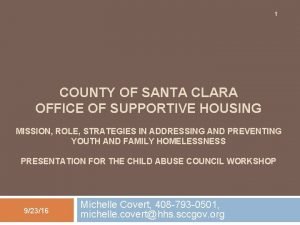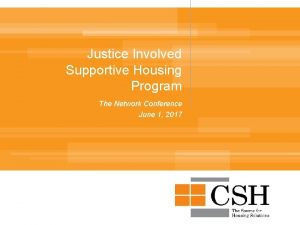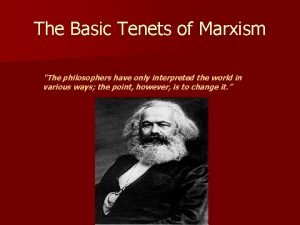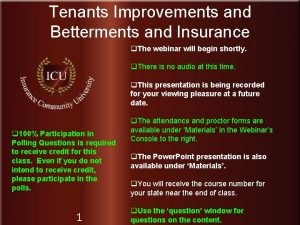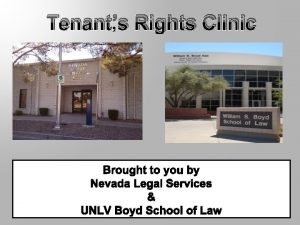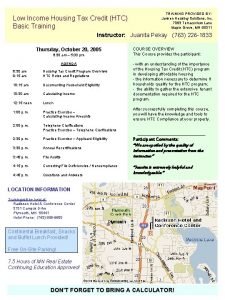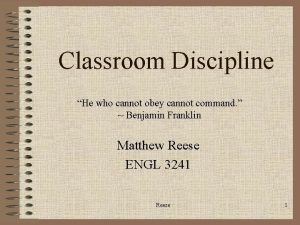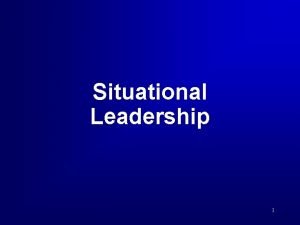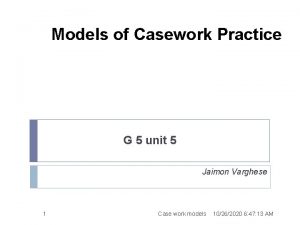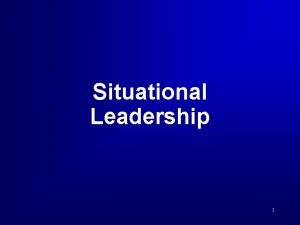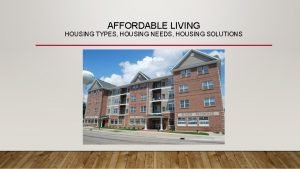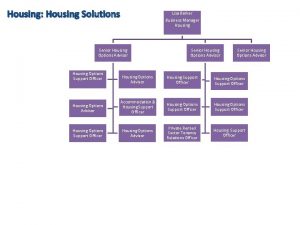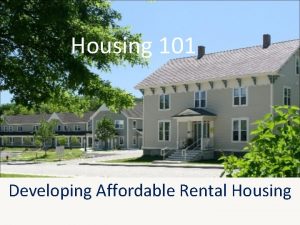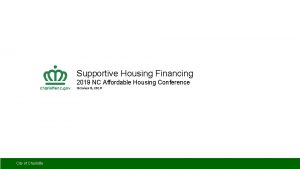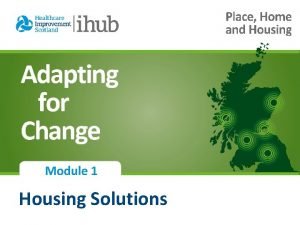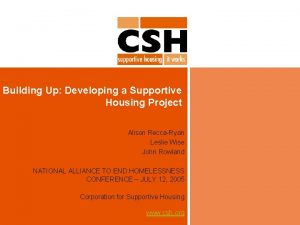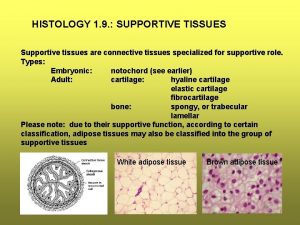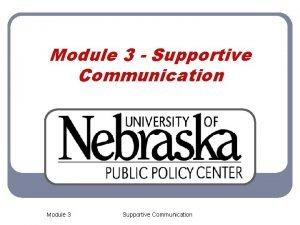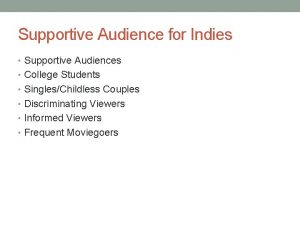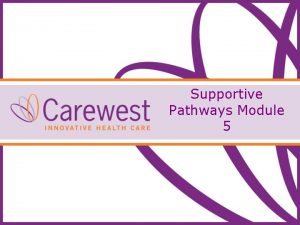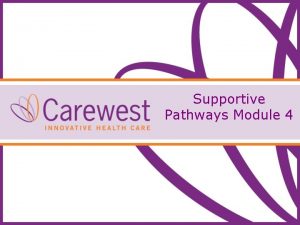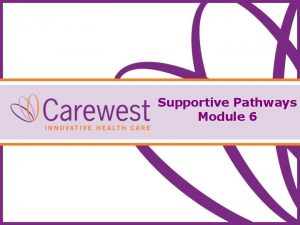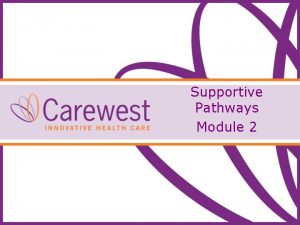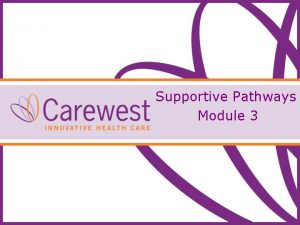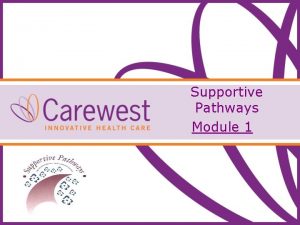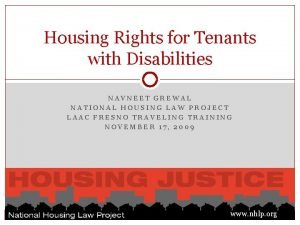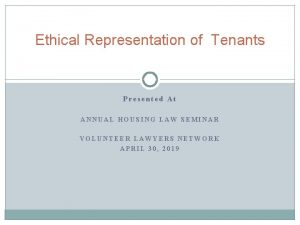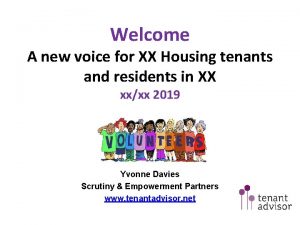Supportive Housing Developing Solutions and Supporting Tenants The






























- Slides: 30

Supportive Housing Developing Solutions and Supporting Tenants The Source for Housing Solutions

What We Do CSH is a touchstone for new ideas and best practices, a collaborative and pragmatic community partner, and an influential advocate for supportive housing. Powerful capital funds, specialty loan products and development expertise Lending Custom community planning and cutting-edge innovations Training & Education Lines of Business Consulting & Assistance Research-backed tools, trainings and knowledge sharing Policy Reform Systems reform, policy collaboration and advocacy

Supportive Housing Training Center

CSH’s Presentation What is supportive housing Supportive housing outcomes Development models Qualified Allocation Plans (MD, VA and DC) Project examples

What is Supportive Housing? 5

How would you describe supportive housing? Permanent, affordable, independent, tenant centered, flexible, voluntary 6

Supportive Housing is not: § Treatment § Transitional § 7 Licensed community care

Defining Supportive Housing Targets households with barriers Tenants sign leases Is affordable Engages tenants in flexible, voluntary services Coordinates among key partners Supports connecting with community

Supportive Housing Outcomes What is Supportive Housing? 9

Core Outcomes for Tenants in SH

Supportive Housing Works Supportive housing costs less than shelter and transitional housing. Emergency room visits significantly decrease. Savings in police and emergency response. Reduced recidivism.

A Strategy that Works for People • • 12 More than 80% of tenants stay housed for at least one year Even when services are not a condition of tenancy, tenants participate at high rates: ü 81% health care utilization ü 80% mental health treatment ü 56% substance abuse services

Development Models

Coordinated Roles Developer Owner Property Manager Service Provider Tenants sustain stable housing

Difference between Affordable and SH Capital Operating Services Affordable PSH

Development Options § Turnkey § Co-Development § Master Leasing § Service Contract

Community Engagement

Housing Models and Community Support Does every project require us to build community support? Whose support do we need for a project?

Working with the Community Building a mutually beneficial relationship with the community Getting involved with community associations or activities Addressing community needs with the project Finding opportunities to educate the community

Six Steps to Building Community Support Step I: Assessmen t and Planning Step II: Political Strategy Step III: Building Active Community Support Step IV: Dealing with Community Concerns Step V: Legal Strategy Step VI: Public Relations/ Media Strategy

Qualified Allocation Plans (QAPs)

Maryland Threshold Requirement § One of four allowed categories is integrated supportive housing (projects dedicating 10 to 25% of units to supportive housing). Scoring Incentives § Up to 14 points for projects dedicating units to households at or below 30% AMI. § Up to 10 points to projects dedicating between 6% and 25% of units to people with disabilities or with special needs. § Up to 10 points to projects with additional services or operating funds committed.

Virginia Scoring Incentives • • • 35 points to developments that reserve a minimum of 75% of units as supportive housing for the homeless Up to 10 points to developments that dedicate 20% of units for housing persons with disabilities. 10 points for developments committing to dedicate a minimum of 20% of total units for permanent supportive housing for homeless.

Washington, DC Threshold Requirement New construction and vacant projects must dedicate 5% of units to supportive housing. Scoring Incentives DHCD can award up to 10 points for up to two of eight objectives, including: § Creating housing for low-income disabled, elderly, or other households with special needs requiring supported living environments. § Creating permanent supportive housing opportunities, with supportive services, for individuals and families who are experienced or at risk of experiencing homelessness. § Creating permanent housing for households living with HIV/AIDS. Other Rental subsidies (project based vouchers and Local Rental Support Program) and services funding available through the Unified RFP.

Project Examples

Crescent Square, Virginia Beach • Virginia Supportive Housing is developer and services provider. • Includes 42 units formerly homeless individuals and 38 units for individuals earning 50 percent or less of the area median income. • Total development costs: $10. 4 million. • CSH provided $300, 000 predevelopment loan.

Crescent Square, Virginia Beach, VA • Each unit will include a kitchenette, living and sleeping area, full bathroom and a closet. Eight of the units will be completely accessible for persons with disabilities. • Amenities include a high-tech security system, community room, computer room, fitness room, laundry facilities, a front desk staffed 16 hours per day, and a landscaped patio with a community garden • Residents sign leases and pay 30 percent of their income in rent with a minimum rent payment of $50 per month. • VSH offers on-site supportive services through case managers who help residents stabilize, retain their housing and reclaim their lives.

Southview Villas, Hope Mills, NC Rural Integrated Supportive Housing 64 units (48 one-bedroom and 16 two- bedroom units)

Southview Villas, Hope Mills, NC Capital LIHTC Equity (Investor: Raymond James) State Tax Credit Cumberland County Community Loan Fund Loan Deferred Developers Fee Bank Loan Total $3, 945, 156 $1, 031, 407 $ 400, 000 $ 113, 615 $ 564, 000 $6, 054, 178 Operating (Annual) Net Rental & Other Income Rental Income from Key Program $ 273, 335 $ 28, 320 Services (Annual) Provided free of charge to residents by Local Lead Agency and its referral agencies, primarily funded by North Carolina Department of Health and Human Services.

Thank you! Holly Denniston-Chase Loan Officer CSH Holly. denniston@csh. org 202. 715. 3985 x 20
 Office of supportive housing santa clara county
Office of supportive housing santa clara county Supportive housing providers association
Supportive housing providers association Fortune society scattered site housing
Fortune society scattered site housing Marxism
Marxism Improvements and betterments insurance
Improvements and betterments insurance Nevada tenants rights
Nevada tenants rights Janken housing solutions
Janken housing solutions Supportive discipline
Supportive discipline Directive behavior and supportive behavior
Directive behavior and supportive behavior Models of case work
Models of case work Enthusiastic beginner disillusioned learner
Enthusiastic beginner disillusioned learner Hình ảnh bộ gõ cơ thể búng tay
Hình ảnh bộ gõ cơ thể búng tay Frameset trong html5
Frameset trong html5 Bổ thể
Bổ thể Tỉ lệ cơ thể trẻ em
Tỉ lệ cơ thể trẻ em Voi kéo gỗ như thế nào
Voi kéo gỗ như thế nào Chụp tư thế worms-breton
Chụp tư thế worms-breton Chúa sống lại
Chúa sống lại Các môn thể thao bắt đầu bằng tiếng bóng
Các môn thể thao bắt đầu bằng tiếng bóng Thế nào là hệ số cao nhất
Thế nào là hệ số cao nhất Các châu lục và đại dương trên thế giới
Các châu lục và đại dương trên thế giới Cong thức tính động năng
Cong thức tính động năng Trời xanh đây là của chúng ta thể thơ
Trời xanh đây là của chúng ta thể thơ Mật thư anh em như thể tay chân
Mật thư anh em như thể tay chân Làm thế nào để 102-1=99
Làm thế nào để 102-1=99 độ dài liên kết
độ dài liên kết Các châu lục và đại dương trên thế giới
Các châu lục và đại dương trên thế giới Thơ thất ngôn tứ tuyệt đường luật
Thơ thất ngôn tứ tuyệt đường luật Quá trình desamine hóa có thể tạo ra
Quá trình desamine hóa có thể tạo ra Một số thể thơ truyền thống
Một số thể thơ truyền thống Cái miệng xinh xinh thế chỉ nói điều hay thôi
Cái miệng xinh xinh thế chỉ nói điều hay thôi
